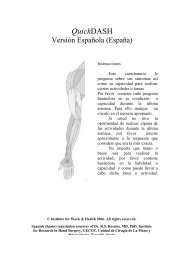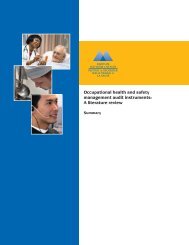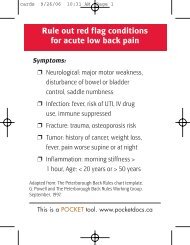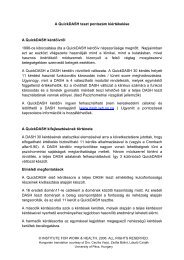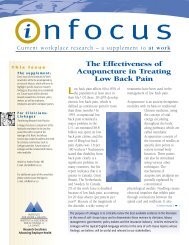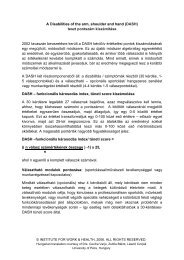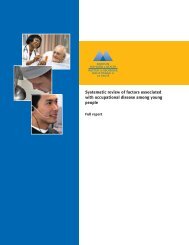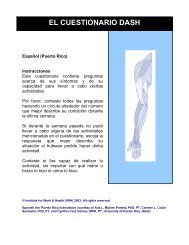A systematic review of injury/illness prevention and loss control ...
A systematic review of injury/illness prevention and loss control ...
A systematic review of injury/illness prevention and loss control ...
- No tags were found...
You also want an ePaper? Increase the reach of your titles
YUMPU automatically turns print PDFs into web optimized ePapers that Google loves.
compensation <strong>and</strong> medical bills is much easier to quantify. Employers knowthat if they have an experience modification ratio/rating (the number used tocalculate workers’ compensation insurance premium) <strong>of</strong> greater than one,their costs will rise. Whereas they may choose not to invest in a trainingprogram <strong>and</strong> still have the same amount <strong>of</strong> injuries, thus saving money upfront.RTW/DM was the only intervention category associated with a strong level<strong>of</strong> evidence in having a positive effect on injuries/<strong>illness</strong>es <strong>and</strong> workers’compensation claims/costs. The RTW/DM studies, except for Brown et al.1992, used “usual care” as the <strong>control</strong>/concurrent comparison group. Thisfact should not be surprising as the programs focused on treating injuredemployees. It would not be ethical or informative to determine if caring forthe employee provided better outcomes than withholding care.A moderate level <strong>of</strong> evidence was found for five intervention categories.• Supervisor practices have a positive effect on reducinginjuries/<strong>illness</strong>es.• Workstation adjustments <strong>and</strong> training have a positive effect onreducing injuries/<strong>illness</strong>es.• Exercise has a positive effect on reducing injuries/<strong>illness</strong>es.• Workstation adjustment alone has no effect on reducinginjuries/<strong>illness</strong>es.• Ergonomic training alone has no effect on reducing injuries/<strong>illness</strong>es.The category <strong>of</strong> workplace adjustments aggregated studies that made differenttypes <strong>of</strong> adjustments. There is not enough evidence to group each adjustmentseparately <strong>and</strong> the study authors typically aggregated all the changes into an“adjustment” category when they performed their analyses. Reporting theeffects <strong>of</strong> adjusting only one piece <strong>of</strong> equipment would be preferable.However, it is not <strong>of</strong>ten practical as most programs would <strong>of</strong>fer a range <strong>of</strong>potential workstation adjustments to accommodate the vast heterogeneity <strong>of</strong>employees <strong>and</strong> workstations <strong>of</strong>ten encountered in <strong>of</strong>fice environments.Similarly, the training <strong>and</strong> exercise interventions in different studies were notidentical in the topics covered or in the way they were administered toemployees.There were enough studies <strong>of</strong> ergonomic training programs to separate themfrom other training programs. Although there is moderate evidence showingthat ergonomic training programs alone do not have a positive effect oninjuries, an important observation is that when they are combined withworkstation adjustments, there is moderate evidence to support a positiveeffect. These findings point to the effectiveness <strong>of</strong> multi-component <strong>injury</strong>A <strong>systematic</strong> <strong>review</strong> <strong>of</strong> <strong>injury</strong>/<strong>illness</strong> <strong>prevention</strong> <strong>and</strong> <strong>loss</strong> <strong>control</strong>programs (IPCs)33



